Intrigued by flowers beginning with “A”? Explore this updated 2025 list featuring common and simple-to-cultivate varieties. Discover the beauty of these amazing blooms!
Do you have a favorite flower starting with “A”? I’d be thrilled to learn about it and explore its unique beauty with you! Let’s discover some amazing “A” flowers together.
Table of Contents
Aster
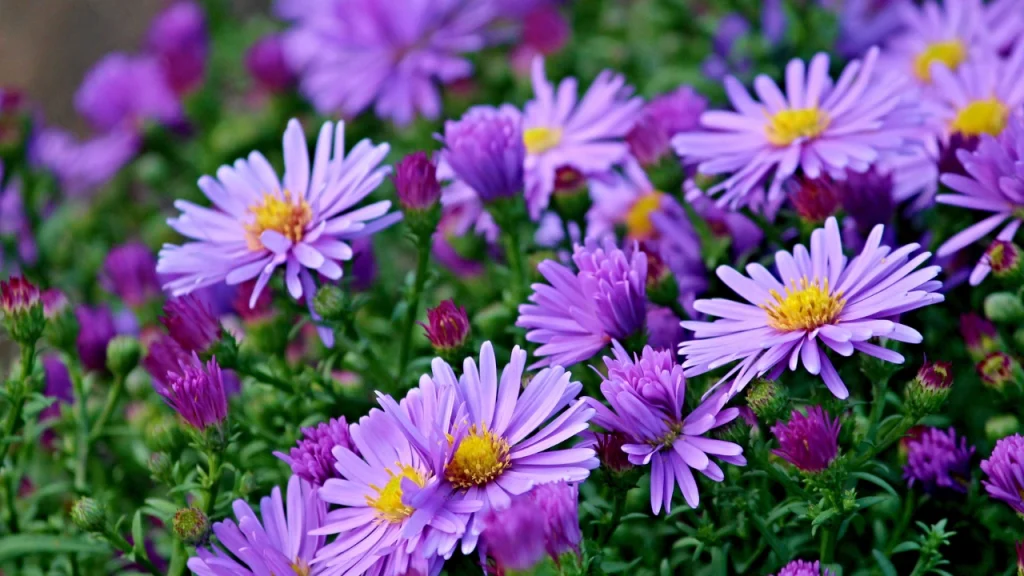
| Common Name | Aster |
|---|---|
| Botanical Name | Aster |
| Family | Asteraceae |
| Plant Type | Perennial |
| Native Range | North America, Europe, Asia |
| Flowering Season | Late summer to fall |
| Mature Size | 1 to 6 feet (30 to 180 cm) tall |
| Sun Exposure | Full sun to partial shade |
| Soil Type | Well-draining, fertile soil |
| Soil pH | Neutral to slightly acidic |
| Bloom Time | Late summer to fall |
| Flower Color | Various shades of purple, pink, blue, white, or yellow |
| Hardiness Zone | 3 to 9 |
| Toxicity | Generally non-toxic |
Asters are a diverse plant genus within the Asteraceae family, encompassing approximately 180 distinct species. Previously, this genus included over 600 species. However, advancements in botanical research led to the reclassification of many into other genera.
Most Aster varieties originate from North America, Europe, and Asia. Only one species is native to South America. These plants flower in late summer and autumn. They bring vibrant hues to gardens and natural settings.
Asters typically reach heights of three to four feet. They bloom in a spectrum of colors, including pink, blue, purple, and white.
Azalea
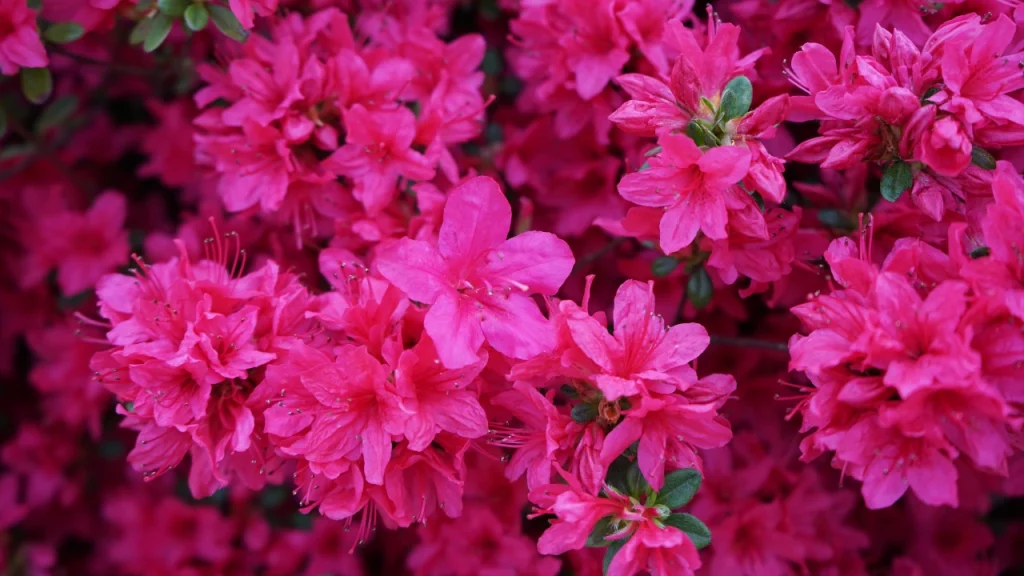
| Common Name | Azalea |
|---|---|
| Botanical Name | Azalea |
| Family | Ericaceae |
| Plant Type | Shrub |
| Native Range | North America, Asia, Europe |
| Flowering Season | Spring, sometimes in fall |
| Mature Size | 2 to 8 feet (60 to 240 cm) tall |
| Sun Exposure | Partial shade to full sun, depending on variety |
| Soil Type | Well-draining, acidic soil |
| Soil pH | Acidic (pH 4.5 to 6) |
| Bloom Time | Spring, sometimes in fall |
| Flower Color | Various shades of pink, white, red, purple, or orange |
| Hardiness Zone | 5 to 9 |
| Toxicity | Mildly toxic if ingested, can cause gastrointestinal discomfort |
Azaleas are beautiful flowering shrubs. They boast vibrant blooms in spring, showcasing colors like white, purple, yellow, and red. Their leaves are elliptical in shape. Azaleas can be either evergreen or deciduous.
Azaleas thrive with at least four hours of daily sunlight. They benefit from shade during intense summer heat. Ensure their soil remains consistently moist, acidic, and nutrient-rich for optimal growth.
Azaleas thrive when planted during spring or autumn. Expect slow growth; full maturity can take a decade. Note: Azaleas are poisonous if ingested, exercise caution.
Azaleas are beautiful additions to any garden, bringing vibrant color and undeniable charm. However, remember to handle these plants with care.
Alstroemeria
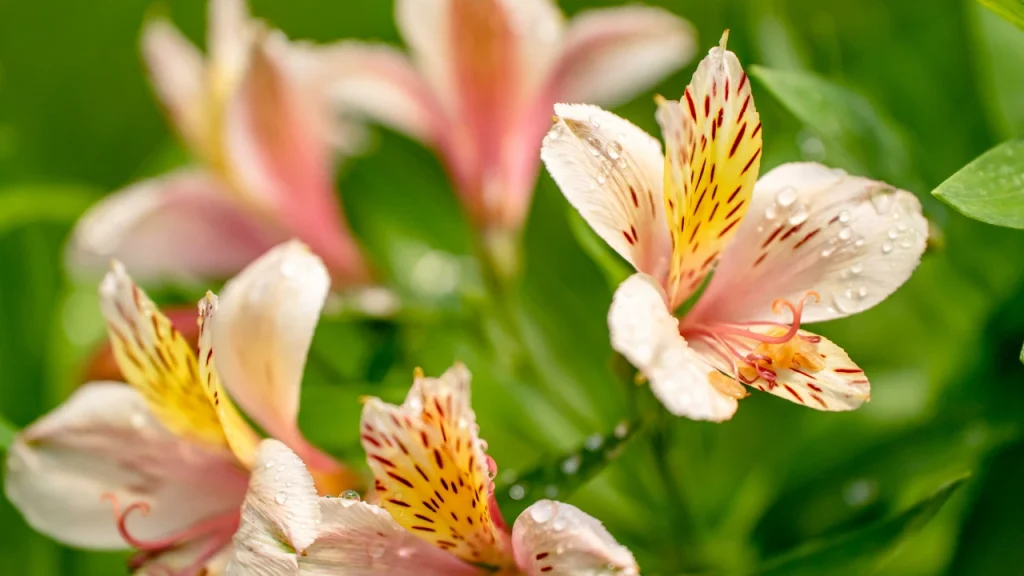
Alstroemeria, often called Peruvian lily, parrot lily, or princess lily, is a stunning flower from the Alstroemeriaceae family. Its roots are in South America, particularly Chile, which boasts the greatest diversity of Alstroemeria species.
Featuring approximately 80 species, Alstroemeria provides diverse choices for home gardens. This is largely due to innovative modern hybrids and cultivars available in 2025.
These beautiful blooms are perfect for cut flower gardens. They offer a wide array of colors, creating a vibrant selection for any gardener. Most Alstroemeria varieties are perennials. They flourish in USDA Plant Hardiness Zones 8 through 10. Gardeners in adjacent zones may also succeed with winter mulching.
Alstroemeria, boasting brilliant colors and continuous blooming, elevates any garden’s charm.
| Common Name | Alstroemeria |
|---|---|
| Botanical Name | Alstroemeria |
| Family | Alstroemeriaceae |
| Plant Type | Perennial |
| Native Range | South America |
| Flowering Season | Late spring to summer |
| Mature Size | 1 to 3 feet (30 to 90 cm) tall |
| Sun Exposure | Full sun to partial shade |
| Soil Type | Well-draining, fertile soil |
| Soil pH | Neutral to slightly acidic |
| Bloom Time | Late spring to summer |
| Flower Color | Various shades of pink, red, orange, yellow, purple, or white |
| Hardiness Zone | 7 to 10 |
| Toxicity | Generally non-toxic |
Amaryllis
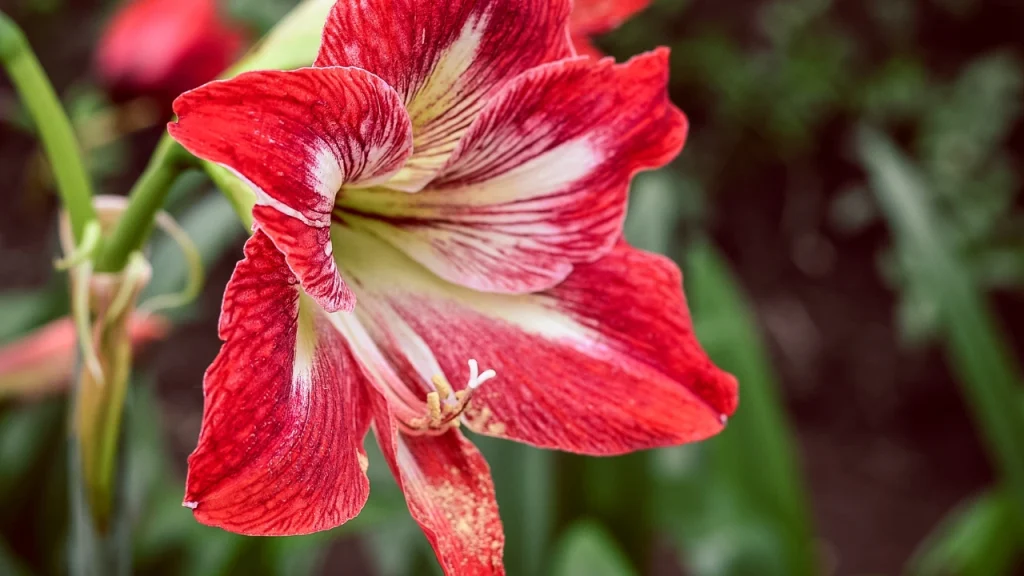
Windflowers, scientifically known as Anemones, are charming plants. Their fragile blossoms dance gracefully in the wind. You’ll find them in a vibrant spectrum of hues. Expect to see red, orange, yellow, blue, purple, white, and pink varieties.
Anemones exhibit rapid growth, often flowering within their initial growing season. Planting is best done during autumn or early spring. Certain anemone varieties boast extended lifespans, while others are more short-lived.
Exercise caution, as consuming large quantities of anemones can be poisonous. Their vibrant blossoms bring charm to gardens, offering a diverse range of colors throughout the year.
| Common Name | Amaryllis |
|---|---|
| Botanical Name | Amaryllis |
| Family | Amaryllidaceae |
| Plant Type | Bulbous Perennial |
| Native Range | South America, Caribbean, and Africa |
| Flowering Season | Winter to spring |
| Mature Size | 1 to 2 feet (30 to 60 cm) tall |
| Sun Exposure | Full sun to partial shade |
| Soil Type | Well-draining, fertile soil |
| Soil pH | Neutral to slightly acidic |
| Bloom Time | Winter to spring |
| Flower Color | Various shades of red, pink, orange, white, or striped |
| Hardiness Zone | 9 to 11 |
| Toxicity | Toxic to pets, may cause gastrointestinal discomfort if ingested |
Anemone
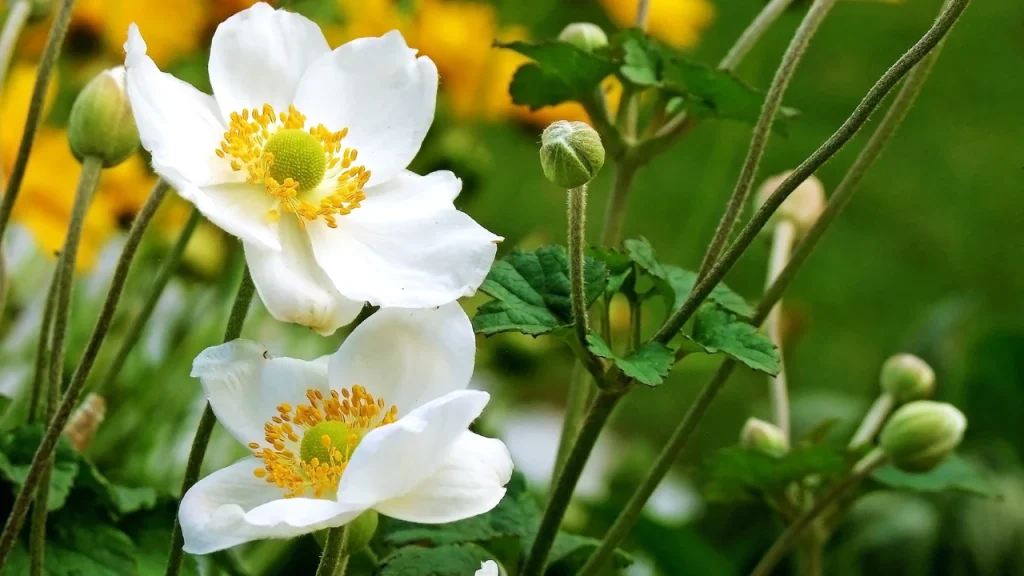
Anemones, often called windflowers, belong to the Anemone genus. These plants are beloved by gardeners for their charming, poppy-shaped blossoms. Their graceful movement in the wind inspired the name “windflowers.” The term “anemone” originates from the Greek word “anemos,” which translates to “wind.”
These vibrant flowers come in a spectrum of colors. Expect to see stunning reds, oranges, yellows, blues, purples, whites, and pinks. Their sizes vary, adding to their charm. The flower stems emerge from clusters of leaves at the base. They can reach a diameter of two to five inches. Certain types boast frilly, double blooms. These resemble large chrysanthemums, offering an extra touch of elegance.
Anemones are generally planted in autumn, late winter, or early spring. Planting is typically done using corms or bare roots. These plants grow quickly and can flower in their initial season. Their lifespan varies by species, ranging from short-lived to potentially lasting for many decades.
Anemones enhance garden aesthetics, but exercise caution. They contain protoanemonin, making them moderately toxic to humans if consumed in large amounts. They are also mildly toxic to pets. Be mindful of this in 2025.
Anemones, known for their diverse colors and sizes, are herbaceous perennials. They add vibrant beauty to gardens throughout the year.
| Common Name | Anemone |
|---|---|
| Botanical Name | Anemone |
| Family | Ranunculaceae |
| Plant Type | Perennial |
| Native Range | Europe, North America, and Asia |
| Flowering Season | Spring to fall |
| Mature Size | Varies by species, generally 1 to 3 feet tall (30 to 90 cm) |
| Sun Exposure | Full sun to partial shade |
| Soil Type | Well-draining, fertile soil |
| Soil pH | Neutral to slightly acidic |
| Bloom Time | Spring to fall |
| Flower Color | Various shades of white, pink, red, purple, or blue |
| Hardiness Zone | Varies by species, typically 4 to 8 |
| Toxicity | Mildly toxic if ingested, may cause skin irritation |
Agapanthus

The Agapanthus, often called Lily-of-the-Nile or African lily, is a stunning perennial plant. It belongs to the Amaryllidaceae family and adds elegance to any garden.
This resilient plant thrives in USDA zones 7 through 11 and originates from South Africa. It boasts impressive clusters of vibrant blue or pure white flowers. These blooms sit atop tall, slender stalks, reaching a mature height of approximately 4 feet (1 meter).
These stunning flowers bloom from June to August. They bring a refined beauty to your garden all summer long.
| Common Name | Agapanthus |
|---|---|
| Botanical Name | Agapanthus |
| Family | Amaryllidaceae |
| Plant Type | Perennial |
| Native Range | South Africa |
| Flowering Season | Summer |
| Mature Size | 1 to 4 feet (30 to 120 cm) tall |
| Sun Exposure | Full sun to partial shade |
| Soil Type | Well-draining, fertile soil |
| Soil pH | Neutral to slightly acidic |
| Bloom Time | Summer |
| Flower Color | Shades of blue, purple, white, or pink |
| Hardiness Zone | 8 to 11 |
| Toxicity | Mildly toxic if ingested |
Angelonia

Angelonia, often called Summer Snapdragon, is a charming flower originating from Central and South America. Its cultivation varies; it thrives as an annual or perennial based on local weather. Angelonia boasts stunning flower spikes in pink, purple, blue, or white hues. These vibrant colors enhance gardens and landscapes beautifully.
This delightful plant flourishes in sunny locations. It needs fertile, well-drained soil with a pH that’s neutral or slightly acidic. Expect blooms from summer through autumn, providing a long season of floral beauty. Reaching a mature size of 1 to 2 feet (30 to 60 cm), Angelonia is perfect for borders, containers, and mass plantings.
Angelonia shines because it’s non-toxic. This makes it safe for gardens with kids and pets. Plus, it draws in beautiful butterflies and helpful pollinators, enhancing any outdoor area with charm and life. It remains a top choice in 2025!
| Common Name | Angelonia |
|---|---|
| Botanical Name | Angelonia |
| Family | Plantaginaceae |
| Plant Type | Annual or perennial |
| Native Range | Central and South America |
| Flowering Season | Summer to fall |
| Mature Size | 1 to 2 feet (30 to 60 cm) tall |
| Sun Exposure | Full sun |
| Soil Type | Well-draining, fertile soil |
| Soil pH | Neutral to slightly acidic |
| Bloom Time | Summer to fall |
| Flower Color | Shades of pink, purple, blue, or white |
| Hardiness Zone | Annual: 9 to 11; Perennial: 8 to 11 |
| Toxicity | Non-toxic |
Allium

| Common Name | Allium |
|---|---|
| Botanical Name | Allium |
| Family | Amaryllidaceae |
| Plant Type | Perennial |
| Native Range | Various regions in Europe, Asia, and North America |
| Flowering Season | Spring to summer |
| Mature Size | Varies by species, typically 1 to 4 feet (30 to 120 cm) tall |
| Sun Exposure | Full sun |
| Soil Type | Well-draining, fertile soil |
| Soil pH | Neutral to slightly acidic |
| Bloom Time | Spring to summer |
| Flower Color | Various shades of purple, pink, white, yellow, or blue |
| Hardiness Zone | Varies by species, typically 4 to 9 |
| Toxicity | Non-toxic |
Ornamental onions, scientifically known as Allium, are captivating flowering plants. They enhance gardens with their unique beauty. Originating from Europe, Asia, and North America, these perennials offer vibrant blooms from spring through summer.
Allium plants, reaching heights of 1 to 4 feet (30 to 120 cm), boast stunning spherical flower clusters. These blooms showcase vibrant colors like purple, pink, white, yellow, or blue. Gardeners adore them for their distinctive and visually appealing flower heads, making them a popular choice in 2025 gardens.
Alliums flourish in sunny locations. They need fertile, well-drained soil with a neutral to slightly acidic pH. These easy-to-grow plants enhance borders, rock gardens, and containers beautifully. Consider them for your 2025 garden plans!
Allium’s non-toxic nature is a major plus, ensuring safety for kids and pets. Its beauty and easy care make it a fantastic garden plant. Expect butterflies and bees to flock to its nectar-filled flowers.
African Daisy

The African Daisy, or Arctotis, is a stunning flower originating from South Africa. This perennial beauty blooms from spring through autumn. Expect a vibrant color palette: purples, pinks, oranges, yellows, and whites.
Growing to a height of 30 to 60 cm, the African Daisy flourishes in sunny locations. It needs well-drained, sandy-loam soil with a pH that’s neutral or slightly acidic. Its bright and beautiful flowers make it a favorite for gardens and landscaping projects.
African Daisies are easy to care for, bringing beauty to your garden without demanding much attention. Plus, they’re non-toxic, making them a safe choice for homes with pets and kids.
In 2025, the African Daisy remains a garden favorite. Its vibrant flowers add joy to borders, pots, and ground cover. This cheerful plant enhances any outdoor space with its beauty.
| Common Name | African Daisy |
|---|---|
| Botanical Name | Arctotis spp. |
| Family | Asteraceae |
| Plant Type | Perennial |
| Native Range | South Africa |
| Flowering Season | Spring to fall |
| Mature Size | 1 to 2 feet (30 to 60 cm) tall |
| Sun Exposure | Full sun |
| Soil Type | Well-draining, sandy-loam soil |
| Soil pH | Neutral to slightly acidic |
| Bloom Time | Spring to fall |
| Flower Color | Various shades of purple, pink, orange, yellow, or white |
| Hardiness Zone | 9 to 11 |
| Toxicity | Non-toxic |
Aquilegia
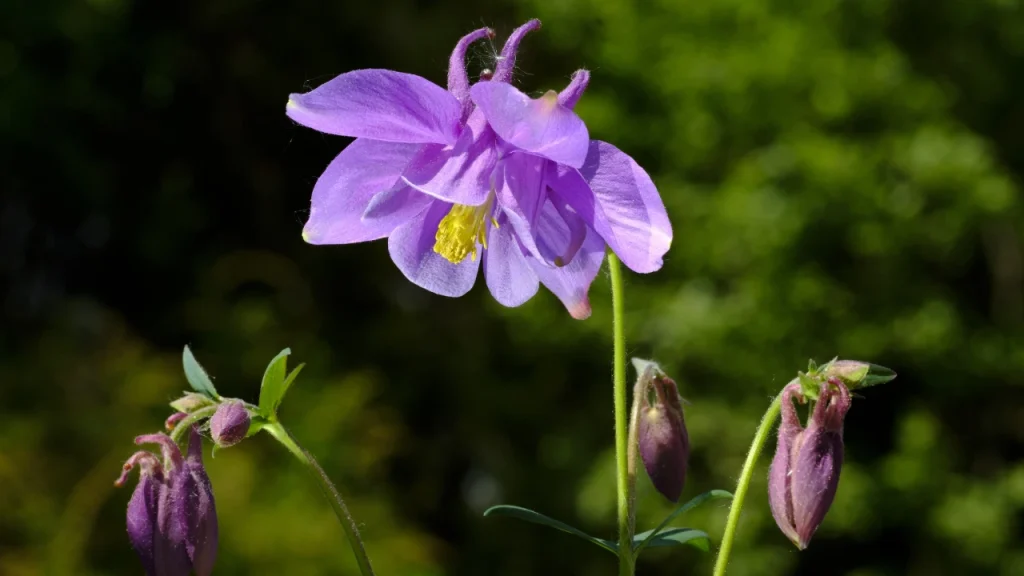
Columbine, scientifically known as Aquilegia, is a captivating perennial blooming across North America and Europe. This elegant flower graces gardens from spring through early summer. Its blossoms display a stunning array of colors, featuring captivating blues, purples, pinks, yellows, and whites.
Aquilegia, growing 1 to 3 feet tall (30 to 90 cm), adapts well to both sunny and partially shaded areas. This makes it a flexible option for various garden designs. It flourishes in fertile, well-drained soil with a neutral or slightly acidic pH level.
Aquilegia, known for its distinctive bell-shaped flowers, brings refined beauty to any garden. These nectar-filled blossoms are highly attractive to vital pollinators like bees and butterflies, enhancing biodiversity.
This delightful flower enhances any garden. However, be aware that it’s mildly toxic if eaten. Despite this, the Columbine’s captivating flowers and its appeal to pollinators make it a favorite for gardeners. It’s perfect for creating a lively and attractive garden.
| Common Name | Aquilegia |
|---|---|
| Botanical Name | Aquilegia |
| Family | Ranunculaceae |
| Plant Type | Perennial |
| Native Range | North America, Europe |
| Flowering Season | Spring to early summer |
| Mature Size | 1 to 3 feet (30 to 90 cm) tall |
| Sun Exposure | Full sun to partial shade |
| Soil Type | Well-draining, fertile soil |
| Soil pH | Neutral to slightly acidic |
| Bloom Time | Spring to early summer |
| Flower Color | Various shades of blue, purple, pink, yellow, or white |
| Hardiness Zone | 3 to 9 |
| Toxicity | Mildly toxic if ingested |
Aubrieta
Aubrieta is a low-growing plant known for its petite, vibrant blossoms. This wildflower thrives across Europe and Asia.
Come springtime, it bursts into life with charming purple, pink, or white blossoms. Expect a height of around 4 to 6 inches and a spread of 1 to 2 feet. Aubrieta thrives in sunny spots with soil that drains easily.
These blossoms typically emerge between late spring and early summer. While generally considered pet-safe, ingestion could cause mild stomach upset.
This plant is simple to maintain and brings vibrant color to gardens in zones 4 through 8.
| Common Name | Aubrieta |
|---|---|
| Botanical Name | Aubrieta deltoidea, Aubrieta cultorum, Aubrieta x cultorum, and others (species and hybrids) |
| Family | Brassicaceae |
| Plant Type | Perennial |
| Native Range | Europe, Asia |
| Flowering Season | Spring |
| Mature Size | 4 to 6 inches (10 to 15 cm) tall and 1 to 2 feet (30 to 60 cm) wide |
| Sun Exposure | Full sun |
| Soil Type | Well-draining, sandy-loam soil |
| Soil pH | Neutral to slightly alkaline (pH 6.5 to 7.5) |
| Bloom Time | Late spring to early summer |
| Flower Color | Shades of purple, pink, or white |
| Hardiness Zone | 4 to 8 |
| Toxicity | Generally non-toxic, but ingestion may cause mild gastrointestinal upset in pets |
Achillea

Yarrow, scientifically known as Achillea, is a stunning perennial wildflower. It thrives across North America, Europe, and Asia. Expect vibrant blooms from summer through autumn. Its flowers display a spectrum of colors: pinks, reds, yellows, whites, and oranges.
Reaching a mature height of 1 to 3 feet (30 to 90 cm), Yarrow flourishes in sunny locations. It needs well-drained, sandy-loam soil with a pH between 6.5 and 7.5. Its delicate leaves and beautiful flower groupings enhance gardens and outdoor spaces.
Yarrow is a resilient plant. It thrives in diverse climates, offering easy care for gardeners. Plus, it’s generally considered safe around kids and pets, making it a worry-free addition to your garden.
Yarrow remains a top pick for stunning, wildlife-friendly gardens in 2025. Its enduring flowers draw butterflies and vital pollinators. Gardeners love its adaptability and beauty, making it ideal for adding natural charm to any outdoor area.
| Common Name | Achillea |
|---|---|
| Botanical Name | Achillea millefolium |
| Family | Asteraceae |
| Plant Type | Perennial |
| Native Range | North America, Europe, and Asia |
| Flowering Season | Summer to fall |
| Mature Size | 1 to 3 feet (30 to 90 cm) tall |
| Sun Exposure | Full sun |
| Soil Type | Well-draining, sandy-loam soil |
| Soil pH | Neutral to slightly alkaline (pH 6.5 to 7.5) |
| Bloom Time | Summer to fall |
| Flower Color | Various shades of pink, red, yellow, white, or orange |
| Hardiness Zone | 3 to 8 |
| Toxicity | Generally non-toxic |
Amaranthus

Amaranth, a popular annual flower, thrives across the Americas, Africa, and Asia. This vibrant plant, also known as Amaranthus, blooms beautifully from summer through fall. Its stunning colors range from rich reds and oranges to sunny yellows, lush greens, and deep purples.
Amaranthus, reaching heights of 1 to 6 feet (30 to 180 cm), flourishes in sunny locations. It needs well-drained, fertile soil with a pH that’s neutral or slightly acidic. Gardeners adore it for its bright and attractive flower heads.
Amaranth, a truly adaptable flower, enhances any garden. Use it in borders, containers, or as bedding. Its enduring blooms and vibrant leaves make it a favorite for stunning garden designs.
Amaranthus is typically non-toxic. This makes it safe to cultivate near pets and kids. Its vibrant colors and ornamental qualities make it a fantastic addition to any garden. It brings beauty and energy to your outdoor areas.
| Common Name | Amaranthus |
|---|---|
| Botanical Name | Amaranthus |
| Family | Amaranthaceae |
| Plant Type | Annual |
| Native Range | Americas, Africa, Asia |
| Flowering Season | Summer to fall |
| Mature Size | Varies by species, typically 1 to 6 feet (30 to 180 cm) tall |
| Sun Exposure | Full sun |
| Soil Type | Well-draining, fertile soil |
| Soil pH | Neutral to slightly acidic |
| Bloom Time | Summer to fall |
| Flower Color | Various shades of red, orange, yellow, green, or purple |
| Hardiness Zone | Varies by species, typically 2 to 11 (USDA zones) |
| Toxicity | Generally non-toxic |
Antirrhinum

Snapdragons, scientifically known as Antirrhinum, are captivating flowers native to Europe, North America, and Africa. These beauties bloom from spring through autumn. They enhance gardens with a vibrant palette of colors. Expect to see pink, red, orange, yellow, white, and purple hues.
Snapdragons (Antirrhinum) typically reach 1 to 3 feet (30 to 90 cm) in height. They flourish in sunny locations. Well-draining, fertile soil with a neutral to slightly acidic pH is ideal. The flower’s distinctive shape resembles a dragon’s mouth, hence the name “Snapdragon.”
Snapdragons thrive as annuals or perennials, adapting to different regional climates. Gardeners adore them for their vibrant, eye-catching flowers. They’re a superb option for injecting color and life into gardens and landscapes.
Snapdragons, also known as Antirrhinum, are generally considered non-toxic. This makes them a safe choice for gardens with pets and children. Their vibrant colors and attractive blooms make them a popular garden addition. They also attract butterflies and other pollinators with their nectar-rich flowers, enhancing your garden’s biodiversity.
| Common Name | Antirrhinum |
|---|---|
| Botanical Name | Antirrhinum spp. |
| Family | Plantaginaceae |
| Plant Type | Annual or perennial |
| Native Range | Europe, North America, and Africa |
| Flowering Season | Spring to fall |
| Mature Size | Varies by species, typically 1 to 3 feet (30 to 90 cm) tall |
| Sun Exposure | Full sun |
| Soil Type | Well-draining, fertile soil |
| Soil pH | Neutral to slightly acidic |
| Bloom Time | Spring to fall |
| Flower Color | Various shades of pink, red, orange, yellow, white, or purple |
| Hardiness Zone | Varies by species, typically 4 to 10 (USDA zones) |
| Toxicity | Generally non-toxic |
Ageratum

Ageratum, often called Flossflower, is a beautiful annual native to Central America. Expect blooms from summer through autumn. Its flowers are delicate, fluffy, and come in delightful blue, pink, or white hues.
Ageratum, reaching a mature height of 6 inches to 2 feet (15-60 cm), flourishes in sunny or partially shaded locations. It needs fertile, well-drained soil with a pH that’s neutral or slightly acidic. Expect vibrant blooms!
Ageratum’s delicate, cloud-like flowers are a favorite for bringing refined beauty and vibrant hues to gardens. Its compact size is perfect for edging, pots, and mass plantings, enhancing any outdoor space.
Ageratum is also non-toxic, ensuring safety for pets and kids. Its charming look and vibrant hues enhance any garden. Plus, its nectar-rich blooms draw butterflies and other vital pollinators.
| Common Name | Ageratum |
|---|---|
| Botanical Name | Ageratum houstonianum |
| Family | Asteraceae |
| Plant Type | Annual |
| Native Range | Central America |
| Flowering Season | Summer to fall |
| Mature Size | 6 inches to 2 feet (15 to 60 cm) tall |
| Sun Exposure | Full sun to partial shade |
| Soil Type | Well-draining, fertile soil |
| Soil pH | Neutral to slightly acidic |
| Bloom Time | Summer to fall |
| Flower Color | Shades of blue, pink, or white |
| Hardiness Zone | 9 to 11 |
| Toxicity | Non-toxic |
Alyssum
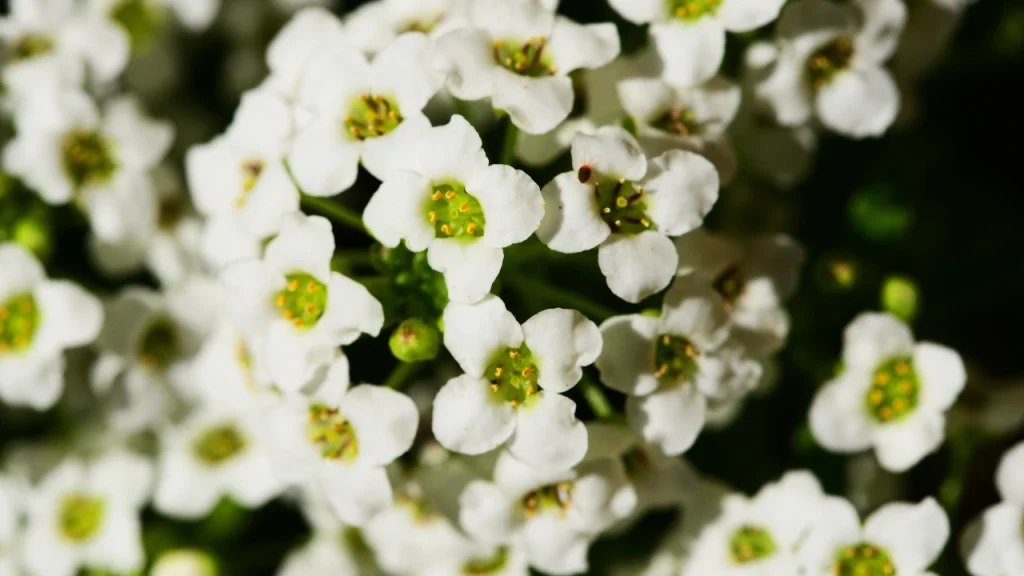
Sweet Alyssum, a vibrant ground cover, presents a delightful array of colors. Expect to see white, pink, purple, or lavender hues. Originating in Europe, this fast-growing plant quickly forms a dense carpet. Its charming, tiny flowers feature a distinctive cross shape with four petals. The foliage consists of gray-green, subtly hairy leaves.
This resilient cool-season flower is simple to cultivate. Start with seeds or young plants. Plant in early spring, once the final frost has passed. In areas without frost, enjoy its beauty all fall and winter. It will even rebloom after the summer heat subsides.
Sweet Alyssum enhances garden aesthetics. However, be aware that it can be invasive in California. It may also exhibit aggressive growth in other U.S. regions.
| Common Name | Alyssum |
|---|---|
| Botanical Name | Lobularia maritima |
| Family | Brassicaceae |
| Plant Type | Annual or perennial |
| Native Range | Mediterranean region |
| Flowering Season | Spring to fall |
| Mature Size | 4 to 8 inches (10 to 20 cm) tall |
| Sun Exposure | Full sun |
| Soil Type | Well-draining, sandy-loam soil |
| Soil pH | Neutral to slightly alkaline (pH 6.0 to 7.5) |
| Bloom Time | Spring to fall |
| Flower Color | White, pink, purple, or lavender |
| Hardiness Zone | 3 to 9 |
| Toxicity | Non-toxic |
Abutilon
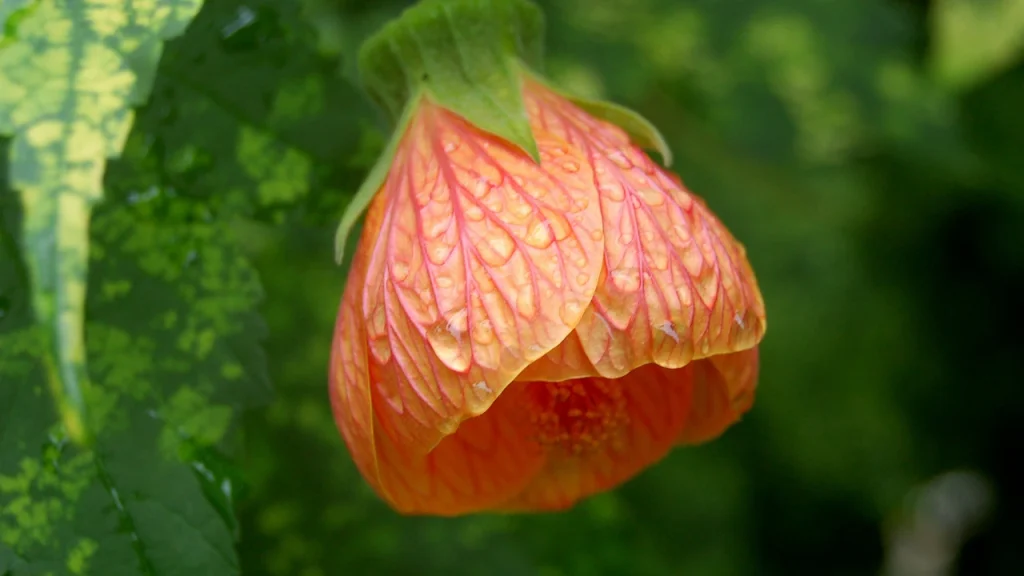
Abutilon, often called Flowering Maple or Chinese Lantern, is a beautiful perennial or shrub. It thrives in tropical and subtropical climates. Expect vibrant colors in gardens and landscapes. Its bell-shaped flowers come in red, orange, yellow, pink, or white.
Abutilon flourishes in both sunny and partially shaded locations. It thrives in fertile, well-draining soil with a neutral or slightly acidic pH. Gardeners love its appealing leaves and bright flowers. It’s a fantastic option for adding beauty and allure to gardens and outdoor areas.
Abutilon’s adaptability is a key highlight. It thrives as both a perennial and a shrub. Being non-toxic, it’s safe for gardens with kids and pets. Enjoy its extended bloom time from spring through fall. Abutilon provides a vibrant and captivating spectacle for everyone.
| Common Name | Abutilon |
|---|---|
| Botanical Name | Abutilon |
| Family | Malvaceae |
| Plant Type | Perennial or shrub |
| Native Range | Tropical and subtropical regions |
| Flowering Season | Spring to fall |
| Mature Size | Varies by species, typically 3 to 10 feet (1 to 3 meters) tall |
| Sun Exposure | Full sun to partial shade |
| Soil Type | Well-draining, fertile soil |
| Soil pH | Neutral to slightly acidic |
| Bloom Time | Spring to fall |
| Flower Color | Various shades of red, orange, yellow, pink, or white |
| Hardiness Zone | Varies by species, typically 8 to 11 (USDA zones) |
| Toxicity | Non-toxic |
Armeria

Sea Thrift, scientifically known as Armeria, is a charming flower native to Europe, Asia, and North America. Expect its delightful blooms in pink, white, or purple from spring through summer.
This plant reaches a height of 6 inches to 1 foot. It thrives in sunny or partially shaded spots with good soil drainage. Its charming flowers and grass-like foliage make it a popular garden choice.
Sea Thrift, or Armeria, poses no threat to your furry friends or little ones. Its resilience allows it to flourish in diverse environments. Enjoy its captivating coastal aesthetic, enhancing your garden’s allure from spring until summer’s end.
| Common Name | Armeria |
|---|---|
| Botanical Name | Armeria |
| Family | Plumbaginaceae |
| Plant Type | Perennial |
| Native Range | Europe, Asia, and North America |
| Flowering Season | Spring to summer |
| Mature Size | 6 inches to 1 foot (15 to 30 cm) tall |
| Sun Exposure | Full sun to partial shade |
| Soil Type | Well-draining, sandy or loamy soil |
| Soil pH | Neutral to slightly alkaline (pH 6.0 to 7.5) |
| Bloom Time | Spring to summer |
| Flower Color | Various shades of pink, white, or purple |
| Hardiness Zone | 3 to 8 |
| Toxicity | Non-toxic |
Anthemis

Anthemis, often called Chamomile or Mayweed, is a delightful perennial wildflower. It originates from Europe, Asia, and North Africa. These lovely flowers bloom from late spring through summer. They add beauty to gardens with their white, yellow, or pink hues.
Anthemis typically reaches a height of 1 to 3 feet (30 to 90 cm). It flourishes in sunny locations. For optimal growth, use well-draining, fertile soil. The ideal pH level is neutral to slightly alkaline, between 6.0 and 7.5.
In 2025, Anthemis remains a top pick for gardeners. Its charming blooms and appealing leaves enhance any garden’s aesthetic. The soothing scent and connection to chamomile tea further boost its popularity.
Anthemis remains a safe and non-toxic choice for gardens with pets and children in 2025. Its hardiness and appeal to helpful insects make it a fantastic garden addition. Expect a beautiful show of colors and fragrances from late spring through summer.
| Common Name | Anthemis |
|---|---|
| Botanical Name | Anthemis |
| Family | Asteraceae |
| Plant Type | Perennial |
| Native Range | Europe, Asia, and North Africa |
| Flowering Season | Late spring to summer |
| Mature Size | Varies by species, typically 1 to 3 feet (30 to 90 cm) tall |
| Sun Exposure | Full sun |
| Soil Type | Well-draining, fertile soil |
| Soil pH | Neutral to slightly alkaline (pH 6.0 to 7.5) |
| Bloom Time | Late spring to summer |
| Flower Color | Various shades of white, yellow, or pink |
| Hardiness Zone | 3 to 9 |
| Toxicity | Non-toxic |
Agave
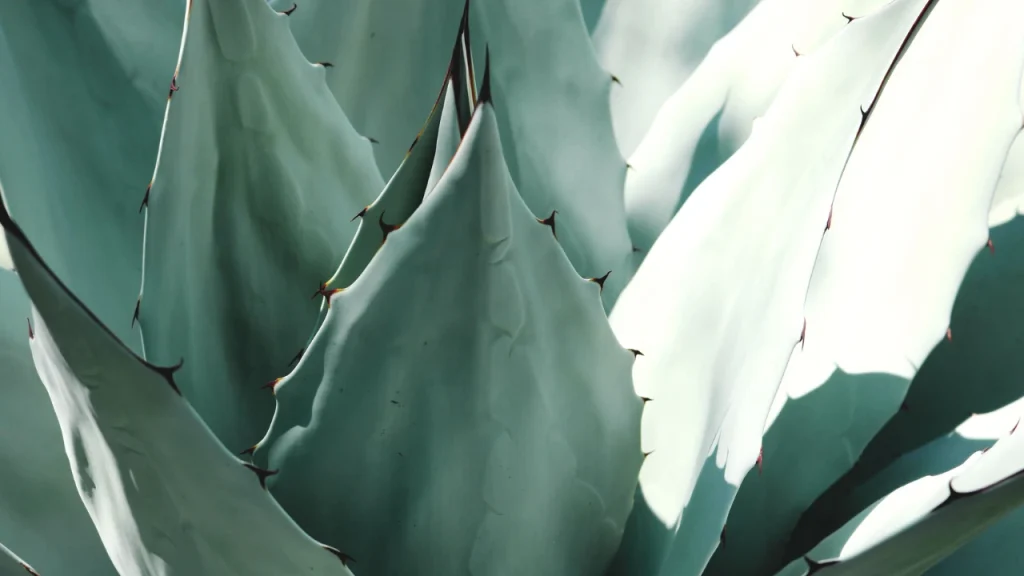
Agave, a captivating succulent, boasts a distinctive and eye-catching form. Originating in the Americas, particularly Mexico, it thrives in arid climates. These plants exhibit a wide range of sizes, reaching heights from 1 to 10 feet (30 cm to 3 meters).
Agave boasts striking, pointed leaves forming rosette patterns. It’s perfectly suited for dry, sun-drenched locations. For optimal growth, provide full sunlight and well-draining soil with a pH ranging from neutral to slightly acidic.
Agave flowering times and bloom colors differ significantly based on the specific species. Certain varieties boast towering flower stalks adorned with vibrant, eye-catching blossoms. Conversely, others exhibit more subtle and less noticeable floral displays.
Agave plants enhance gardens with their unique aesthetic. However, be aware that certain varieties are poisonous to both people and animals. Always identify the specific agave species before planting to ensure safe handling and cultivation practices.
Agave plants are favored for xeriscaping and bringing desert beauty to gardens. Their unique look and resilience make them a top pick.
| Common Name | Agave |
|---|---|
| Botanical Name | Agave |
| Family | Asparagaceae |
| Plant Type | Succulent |
| Native Range | Americas, primarily Mexico |
| Flowering Season | Varies by species |
| Mature Size | Varies by species, typically 1 to 10 feet (30 cm to 3 meters) tall |
| Sun Exposure | Full sun |
| Soil Type | Well-draining soil |
| Soil pH | Neutral to slightly acidic |
| Bloom Time | Varies by species |
| Flower Color | Varies by species |
| Hardiness Zone | Varies by species, typically 8 to 11 (USDA zones) |
| Toxicity | Some species are toxic to humans and pets, check specific species |
Aconitum
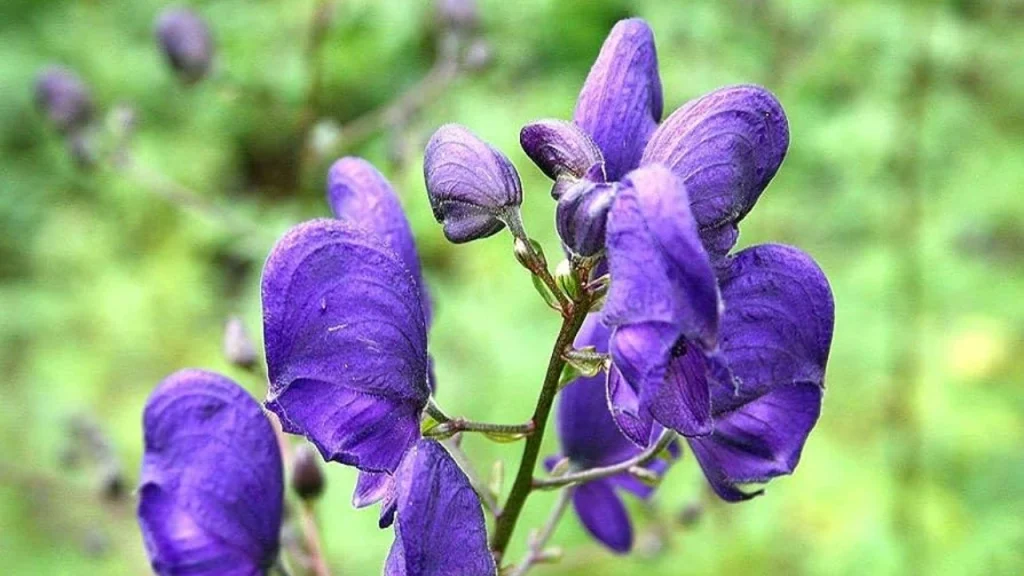
| Common Name | Aconite, Monkshood, Wolfsbane |
|---|---|
| Botanical Name | Aconitum |
| Family | Ranunculaceae |
| Plant Type | Perennial |
| Native Range | Temperate regions of Asia, Europe, and North America |
| Flowering Season | Summer to early autumn |
| Mature Size | Varies by species, typically 2 to 6 feet (60 to 180 cm) tall |
| Sun Exposure | Partial shade to full sun |
| Soil Type | Moist, well-draining soil |
| Soil pH | Neutral to slightly acidic |
| Bloom Time | Summer to early autumn |
| Flower Color | Various shades of blue, purple, or white |
| Hardiness Zone | Varies by species, typically 3 to 7 (USDA zones) |
| Toxicity | Highly toxic due to Aconitine alkaloids |
Aconitum, often called Aconite, Monkshood, or Wolfsbane, is a captivating collection of perennial plants. They boast unique and eye-catching flowers. Originating from temperate zones in Asia, Europe, and North America, these blossoms bring a magical feel to gardens and outdoor spaces in 2025.
Aconitum plants generally reach heights of 2 to 6 feet (60 to 180 cm). They showcase beautiful flowers in blue, purple, or white hues. These plants flower from summer through early fall, enhancing landscapes with their captivating colors.
Aconitum flowers possess striking beauty. However, exercise extreme caution when handling them. They contain Aconitine alkaloids, making them highly poisonous. Prioritize safety during planting or any interaction with these plants.
Aconitum plants, known for their distinctive look and ties to old stories and healing practices, continue to intrigue gardeners and plant lovers. Remember, these beautiful flowers are poisonous, so handle them with care.
Bottom Line
I trust you enjoyed this flower compilation. If you have a favorite flower starting with “A,” let me know! I’d be happy to add it to the list.
You might also find these articles interesting: